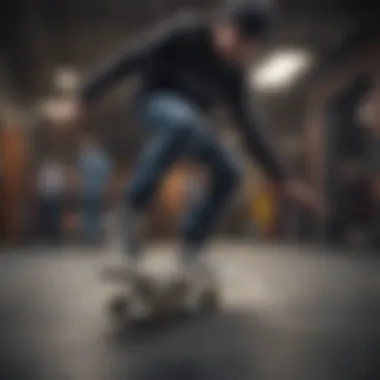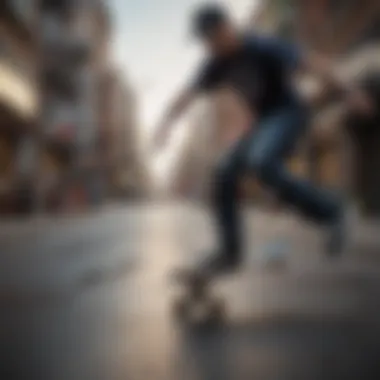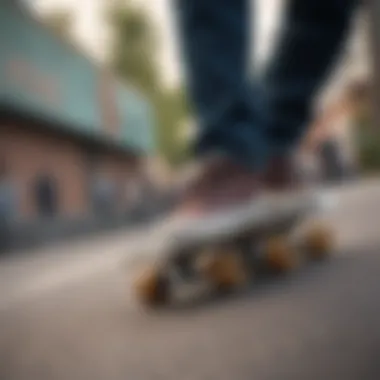Andy Anderson: The Art and Technique of Skateboarding


Intro
In the world of skateboarding, few names resonate like Andy Anderson. He's a figure that embodies the spirit of freedom, creativity, and innovation on four wheels. Anderson's journey is not merely defined by the height of his ollies or the complexity of his tricks; it's a rich tapestry woven with artistry and personal expression. This article delves into the vibrant universe of Andy Anderson's contribution to skateboarding and his unique approach that marries art with athleticism.
Anderson’s influence stretches beyond tricks and stunts. He has crafted a distinct style that speaks volumes about the cultural aspects of skating. As we navigate through his progression as a skater, his signature moves, and the artistic elements that accompany his style, we'll not only discover his technical mastery but also the profound impact he has had on the skateboard community. From his philosophy towards skating to the evolution of his gear and community engagement, each element plays a crucial role in defining who Andy Anderson is today.
Through this exploration, readers will gain a deeper understanding of what it means to be not just a skateboarder but an artist in a realm often dominated by pure athleticism. Anderson shows us that skating transcends just tricks; it's about expressing oneself, celebrating community, and redefining what's possible on a skateboard.
Prolusion to Andy Anderson
Andy Anderson’s journey in the world of skateboarding is a tale woven into the fabric of extreme sports culture. Understanding his life helps illustrate not just the evolution of a skater, but also the broader dynamics within the skateboarding community. Anderson is a personification of creativity on wheels, and examining his background provides insight into the influences that shaped his artistry and innovative techniques.
This section discusses a critical juncture of Andy’s life, laying the groundwork for everything that follows. By exploring his roots, we not only gain a better sense of the challenges he faced but also appreciate the determination required to navigate the often turbulent world of skateboarding.
Background and Early Life
Andy Anderson was born and raised in the heart of Vancouver, Canada. His surroundings—lush forests, rugged coastlines, and an eclectic blend of cultures—provided an inspiring backdrop for his formative years. His childhood was spent forging friendships and embarking on adventures that blended creativity with physical challenge. Growing up, the fusion of art and athleticism seemed to resonate strongly with him.
His family background was equally diverse. With parents who appreciated the arts, Andy was encouraged to express himself creatively from a young age. They exposed him to various forms of artistic expression—from painting to photography. This early immersion in artistic endeavors would eventually contribute to his unique style as a skateboarder.
Many kids during this time fell in love with traditional sports, but Andy was drawn to skateboard culture because it spoke to his desire for freedom and self-expression. The small skate parks scattered around the city became his playground, a setting where he could explore both movement and artistry. Each jump and trick he executed seemed to pulse with a narrative of its own.
Initial Interest in Skateboarding
After being introduced to skateboarding by an older cousin, Andy quickly developed a fascination with the sport. Initially, he struggled to maintain his balance and execute simple tricks, but these challenges only intensified his determination. There was something about the feeling of carving through the air and the sound of the board rolling across the pavement that ignited a spark in him—one that would only grow brighter.
The skateboard became an extension of himself, and with time, he honed his skills more deliberately. For Andy, skateboarding wasn't just about the tricks; it was also about the community, the culture, and the absolute thrill of gliding over asphalt. Early experiences at local skate shops introduced him to the gear that would soon become a hallmark of identity for many skaters.
In his early teens, he began connecting with other skateboarders, exchanging tips, and even collaborating on small skate videos. What started as a hobby soon evolved into an obsession, drawing him deeper into the world of skateboarding, where creativity and competition danced harmoniously. His initial interest marked the inception of a path filled with artistic exploration and technical proficiency that would define his future.
The Evolution of Skateboarding Skills
The evolution of skateboarding skills is crucial in understanding the impact and legacy of Andy Anderson. It's not just about the tricks or the maneuvers; it encompasses a journey, a transformation of both the sport and its practitioners. Through the years, skateboarding has morphed from a simple pastime into a complex art form that blends style, creativity, and physical prowess. This section delves into how Andy Anderson's journey exemplifies this evolution, highlighting key milestones in his career and the unique characteristics that define his skating style.
Key Milestones in Anderson's Career
Anderson's career is marked by several pivotal moments that have shaped his status as a prominent figure in skateboarding. One noteworthy milestone occurred during his teenage years when he entered his first major competition. It was a local event where he first showcased his exceptional flair and innovation. Many observers remarked on his ability to seamlessly combine fluid movements with intricate tricks, a hallmark that would define his approach to skating.
Additionally, Andy was instrumental in the shift towards street skating, particularly in the early 2000s. This period saw him exploring urban landscapes and using them as canvases for his artistic expression. Some significant competitions further pushed his limits, including the X Games, where he not only competed but redefined perceived possibilities in the competitive realm of extreme sports.
In another milestone, Anderson took a risk to push the boundaries of skateboard designs, collaborating with various brands to craft equipment that enhanced performance and reflected his artistic vision. These innovations set new standards in the industry and inspired many upcoming skaters to embrace creativity prominently in their practice.
Defining Characteristics of His Skateboarding Style
When discussing Andy Anderson's skateboarding style, several defining characteristics emerge. His technique exhibits an uncommonly fluid transition between tricks, reflecting his background in artistic practices. This fluidity allows him to link various maneuvers in a way that feels effortless yet highly technical.


Moreover, his choice of gear is intrinsically tied to his skating style. Anderson favors boards that offer flexibility, allowing for a variety of tricks that require both precision and adaptability. The shapes and designs often reflect his own artistic flair, linking his dual passions of skating and creating art into a cohesive expression.
He often incorporates elements from other disciplines into his skating, further distinguishing his style. Whether it's the influence of surfing or even dance, there’s a rich tapestry from which he draws inspiration. His willingness to defy conventions and take daring risks has encouraged a whole generation of skaters to explore their individual artistry within the sport.
"Skateboarding is so much more than just getting from point A to B—it's about expression and freedom on wheels."
In summary, Andy Anderson's evolution as a skateboarder is not just a series of career highlights but a testament to the ever-changing landscape of skateboarding itself. As athletes like him continue to innovate, they expand the definitions of the sport, inspiring others to find their own unique paths in the world of skateboarding.
Innovative Techniques Introduced
The realm of skateboarding has always been a space where creativity meets athleticism. The importance of innovative techniques is paramount, especially when discussing a figure like Andy Anderson. His evolution as a skater is a testament to how unique artistry in skateboarding can transform the sport itself. By pioneering new approaches to tricks and maneuvers, Anderson not only pushes personal boundaries but also inspires a generation of skaters to think outside the box. This section will delve deeply into the nuances of Anderson's signature moves and the significant influence art has had on his techniques.
Signature Moves and Their Implementation
Anderson's signature moves stand as pillars of his skateboarding identity. Each trick reflects his creativity and technical mastery. One well-known trick is the "Anderson Flip", a maneuver where he combines elements of a traditional kickflip, but with an added individual flair that embodies his artistic vision.
- Execution: To implement this move, Anderson often starts with a solid stance, ensuring proper foot placement. He leverages his body’s momentum while applying rotational force, resulting in a clean but stylish flip. It's a visual spectacle that combines competition-level skill with artistic expression.
- Impact: Beyond the visual appeal, this trick resonates with upcoming skaters, encouraging them to break free from conventional techniques. Andy Anderson shows that skateboarding is not just about landing tricks but also about making them uniquely yours. Travelers on this path will see how important it is to reflect personal style in their approach.
When skaters witness him perform, they’re not just seeing a move; they’re seeing what it means to embrace personality in sport. Anderson effectively communicates that skateboarding is a blend of art and technical skill, which ultimately resonates with his audience.
Influence of Art on Skateboarding Techniques
The interplay between art and skateboarding is crucial, and Anderson's approach embodies this blend beautifully. He considers skateboarding not just a sport but a canvas where one can express emotions and creativity. His engagement with various art forms, from street art to digital graphics, infuses his techniques with a flavor that often feels fresh and unexpected.
- Philosophy: Anderson believes that every trick can tell a story. This view prompts him to innovate continually, reflecting his thoughts and emotions in the maneuvers he creates. For instance, you might notice a certain flow or rhythm in his moves, akin to a well-crafted piece of art.
- Cultural Significance: Art's influence goes beyond aesthetics. It constructs a narrative within skateboarding culture itself. As Anderson illustrates his path through artistic expression, he paves the way for others to explore their creative spirit in extreme sports. Skaters are encouraged to see their use of engraved designs on their boards, graphics on their clothing, and overall style not simply as personal choices but as extensions of their artistry.
In summary, Andy Anderson's innovative techniques in skateboarding, highlighted by his signature moves and artistic influences, demonstrate how artistry does more than decorate the sport – it transforms it.
"In every trick lies the essence of an artist’s heart, waiting to burst into view."
Through this lens, one can appreciate the multifaceted nature of skateboarding, where personal style and creativity redefine boundaries. Anderson not only reshapes the tricks themselves but also inspires a collective shift in perspective for skaters everywhere.
Cultural Impact of Andy Anderson
Andy Anderson's contribution to skateboarding transcends mere athletic skill; it intertwines deeply with cultural shifts, attitudes, and the evolution of the sport itself. His approach to skateboarding is not just about performing tricks, but about creating a canvas of expression that resonates with many. This section delves into the cultural impact of Anderson, particularly how his artistry and techniques have mirrored and shaped youth culture while inspiring aspiring skaters.
Role of Skateboarding in Youth Culture
Skateboarding holds a mirror to youth culture, acting as both a reflection and an influencer. It's more than just a pastime; it's a lifestyle embraced by many young people worldwide. For many, the skatepark becomes a stage and a community center, a place where friendships are forged and identities formed. Anderson's unique style exemplifies this connection. His emphasis on creativity gives skaters permission to express themselves beyond what is seen at standard skate competitions.
Among the tricks and techniques, there's an underlying philosophy that skateboarding embodies freedom. It represents a break from conventional norms. Young skaters take to the streets, finding their passion, their voices, and their community. Anderson's role in this cultural landscape cannot be overstated. Through his artwork and skating, he invites youth to embrace their individuality and think outside the box.
“Skateboarding is like a language; it tells your story without needing words.”
Anderson's Influence on Upcoming Skaters
Anderson has undoubtedly left a significant mark on the next generation of skaters. He has become not just a seasoned pro but also a mentor in the skateboarding world. His authenticity and passion resonate deeply, attracting a following of skaters eager to emulate his techniques and ethos. Young skaters watch his videos, study his moves, and are inspired to infuse artistry into their own sessions.


- Innovation as a Standard:
- Artistic Expression:
- Community Engagement:
- Anderson emphasizes the importance of creativity over mere technicality. He encourages budding skaters to think creatively, pushing the boundaries of the sport.
- His artwork has inspired skaters to use their boards as canvases, promoting self-expression. This encourages personal storytelling through skating.
- Anderson’s collaborative nature has fostered partnerships with other artists and skaters, showcasing the rich tapestry of culture within skateboarding.
Anderson’s influence resonates on social media as well. Platforms like Instagram and TikTok have given rise to a new era of skaters who not only showcase their tricks but also connect with the community. By sharing their journeys and styles, they carry forth Anderson’s ethos of creativity and individuality.
Skateboarding Gear and Equipment
Skateboarding gear and equipment serve as the backbone of any skater's journey, playing a pivotal role in both performance and safety. For someone like Andy Anderson, equipment goes beyond mere functionality; it becomes an extension of their artistry. The right gear not only enhances performance but also influences the style and expression of the skater. It's the difference between gliding with confidence down the pavement and hesitating at the edge of a trick that seems just out of reach.
In this context, understanding the elements that constitute effective skateboarding equipment cannot be overstated. This includes everything from the deck and trucks to wheels and safety gear. Each component has its unique impact on how a skater rides, performs tricks, and interacts with both the board and the environment. Plus, with the constant evolution of materials and designs, today's gear often comes with heightened durability and performance capabilities.
Analysis of Anderson's Preferred Equipment
Andy Anderson's choice of equipment reflects his distinct approach to skateboarding. Selecting the right skateboard deck is crucial to achieving the intended performance. Anderson has been seen riding boards with a specific length and width that allow for greater control. His boards often sport a flared nose and tail, which help with pop and ease in completing tricks.
- Deck Material: Typically, Anderson prefers decks made from 7-ply maple wood; it's both sturdy and responsive, allowing for a great balance between flexibility and rigidity.
- Wheels: When it comes to wheels, he often opts for harder durometers, which provide a faster ride on smoother surfaces while enhancing trick responsiveness.
- Trucks: His choice in trucks leans towards lightweight yet durable options that can withstand various grinding techniques, crucial for his signature moves.
Anderson’s gear doesn’t just enhance performance; it’s also a canvas for his artistic expression. Many of his boards feature vibrant graphics that resonate with his personal style, further emphasizing how gear can reflect individuality.
Impact of Gear on Performance
The performance of a skateboarder hinges significantly on their equipment, and for Andy Anderson, this is particularly pronounced. The interplay between gear quality and the skater’s ability can’t be ignored. A well-built deck can amplify the precision of tricks, while well-chosen wheels can provide better grip and speed.
- Stability and Control: The right trucks allow for improved stability, especially when performing technical tricks. This stability is crucial when executing fast spins or flips where balance is key.
- Speed and Agility: Wheels affect everything from rolling speed to traction when turning. Having the right wheels for different skate park surfaces can make or break a session.
Striking a balance between comfort and performance is fundamental. As Anderson's style evolves, so too does his gear. Experimentation with new materials and designs often leads him to try cutting-edge innovations that could amplify his artistry on the board.
"In skateboarding, the connection between the rider and their board is where art meets physics."
The Community of Skateboarding
The community of skateboarding extends beyond mere tricks and techniques; it interweaves friendships, support systems, and a shared passion that transcends age and geography. For Andy Anderson, this community has played a pivotal role not just in his growth as a skater but also in shaping the very essence of a culture that values creativity, resilience, and collaboration. Skateboarding isn’t solely a sport; it’s a lifestyle rich with stories.
Engagement with Fans and Followers
Anderson's connection with fans is practically a blueprint for modern skateboarding athletes. He manages to forge a bond with his followers that feels personal and genuine. Social media platforms give him the opportunity to showcase his artistry, share raw, behind-the-scenes moments, and even engage in real-time feedback. For example, he might post a video of a new trick he’s been working on and explore followers’ opinions through comments. This two-way street not only fosters a sense of belonging among enthusiasts, but it also refines Anderson's own skills based on community insights.
Moreover, these engagements extend to physical meet-ups, demos, and skate park events. Simply attending these gatherings can catalyze new friendships and inspire young skaters to take their craft seriously. As much as every flip and rail slide reflects technical prowess, it’s the community aspect that turns skateboarding into a passion. Who hasn’t run into an old buddy at a park, only to realize they had been silently cheering for each other from different corners of the world?
"Skateboarding is more than just a sport; it's a unity, a family. It's more than the board itself; it's about the people you share the streets with."
– A skateboarding enthusiast


Collaborations and Partnerships
Collaboration is the lifeblood of skateboarding, and Andy Anderson exemplifies this ethos through partnerships that echo his artistic flair. Rather than existing in isolation, he seeks partnerships that amplify his vision. Working with brands like Santa Cruz Skateboards and Independent Trucks provides a canvas for his creativity, allowing him to imprint his artistic style on products that resonate with skaters.
These collaborations often go beyond traditional advertising. Interactive campaigns, art-inspired skate decks, and unique apparel collections are examples where both Anderson’s artistic vision and the brands’ ethos come together to create something fresh and inspiring. This gives fans not only the chance to own a piece of skate history but also feel connected to Anderson's journey.
The skate community thrives on the creativity shared through these partnerships. Other skaters often reap the benefits, as a well-designed product enhances their experience and reflects their individual styles. In turn, these collaborations foster a continuous cycle of innovation and inspiration, keeping the spirited heart of skateboarding alive and kicking.
In essence, the community of skateboarding is nuanced and dynamic, from the interactions Anderson has with his fans to his partnerships that unlock new horizons and possibilities. It's an ever-intertwining tapestry of creativity and support, fostering growth not only for Andy Anderson but for skaters around the world.
Future Directions in Skateboarding
In contemplating the future of skateboarding, one cannot deny the inherent synergy between innovation and progress in this dynamic sport. It is tantamount to shedding light on the roots of skateboarding culture and moving forth into uncharted territories. Andy Anderson, through his artistry, epitomizes this evolutive spirit, and his journey offers a valuable lens through which to speculate on potential advancements in skateboarding techniques and technology.
Potential Innovations in Technique
When we look at the future of skateboarding techniques, imagine the tantalizing possibilities. Advanced training methods could become prominent. Think about virtual reality simulations that allow skaters to practice complex tricks without leaving their living rooms. This mix of play and training might lead to the development of new maneuvers and skills that are currently unattainable on traditional terrain. This tech-savvy approach can also enhance understanding of physics behind tricks by providing angles and scales that might otherwise go unnoticed.
Moreover, the integration of biomechanics into skateboarding cannot be overlooked. Tracking devices could analyze a skater's movements in real time, providing feedback on posture, balance, and techniques. This could open the door not just for personal improvement but also for coaching methods that have not yet been pioneered. Simply put, the marriage of biomechanics and skateboarding is not just far-fetched; it's on the horizon.
Beyond this, we could witness a renaissance of art-based techniques in skateboarding. Just as Anderson has blended artistry with skating, an entire generation of skaters might draw inspiration from various art forms, leading to new styles that challenge the way we think about technical maneuvers.
"The beauty of skateboarding lies not only in tricks but in how those tricks can morph into expressions of individuality, reflecting an ever-changing culture."
The Role of Technology in Skateboarding
Technology plays an undeniably critical role in shaping the trajectory of skateboarding. From improved materials for skateboards—lighter, stronger, more agile—to wearable tech that monitors performance, the impacts have been significant. Today's skaters are seeing the advantage of high-grade materials like carbon fiber, adding speed and maneuverability. The very boards that skaters use will continue to evolve, synthesized with insights from aerospace engineering, leading to an uptick in performance and creative performance configurations.
Furthermore, social media channels are fostering a new wave of skaters who seek instant feedback on their skills. Platforms like reddit.com and facebook.com allow for quick sharing of not just tricks, but full-blown tutorials. The cross-pollination of ideas is accelerating at a pace not seen before. Crowdsourcing, if applied to skateboarding communities, could lead to collaborative projects aimed at inventing new board designs and trick technologies, thus establishing a direct link between the skater's creativity and technical advancements.
The future is bright, and while traditional elements will always have their place, it’s clear that skateboarding is gearing up to embrace an evolving framework of innovation and technology that will undoubtedly propel it into a thrilling new era.
Finale
In the realm of skateboarding, Andy Anderson stands as a luminary whose contributions extend beyond mere tricks on a board. His influence encapsulates not only the technical prowess of skateboarding but also an artistic elegance that has enriched the culture surrounding the sport. This conclusion focuses on the manifold elements that outline Anderson's impact, the benefits of his innovative approach, and the considerations surrounding the future of skateboarding as influenced by leaders like him.
Recap of Anderson's Contributions
Anderson’s journey is marked by a unique synergy between art and skateboarding. He has infused creativity into every facet of his skating. Key contributions include:
- Innovative Techniques: Anderson has redefined conventional moves, carving out signature tricks that challenge the norm. His ability to combine tricks with fluidity sets him apart.
- Artistic Element: Beyond technical skills, he treats the skateboard as a canvas, often utilized to express emotions and frame narratives, turning skating into a visual art form.
- Cultural Advocate: Through his skateboarding, he has fostered a sense of community, connecting diverse groups of skaters worldwide. His participation in events and grassroots initiatives highlights how skating can be a unifying force.
"Skateboarding isn't just a sport; it's a lifestyle. It’s a way of thinking—where art and technique collide beautifully," says Andy Anderson.
These contributions coalesce to craft a narrative of innovative skateboarding that resonates with thrill-seekers and inspires upcoming generations.
Acknowledging Future Leaders in Skateboarding
Looking ahead, the skateboard community is likely to witness an evolution rooted in the principles laid out by pioneers like Anderson. The future leaders in this field are shaping up through:
- Integration of Technology: Innovations in gear and skating technology will continue to emerge. Future skaters will likely harness digital tools to push boundaries to further refine their techniques.
- Emphasis on Community: Just as Anderson did, upcoming leaders will prioritize community engagement. This aspect will solidify skateboarding's role as a social connector rather than a mere sport.
- Artistic Exploration: With a rising emphasis on self-expression, it is anticipated that more skaters will develop personalized styles and artistic interpretations, reinforcing that skateboarding can indeed be a form of art.
In recognizing these future leaders, the skateboard community positions itself for ongoing evolution and growth, ensuring that the sport remains both vibrant and relevant in the years to come.







